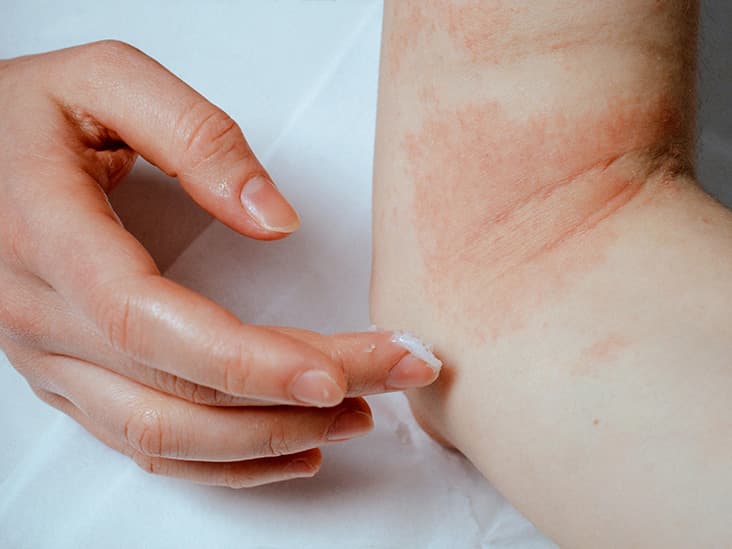
If you experience skin itching and redness often, you might have eczema. This skin condition is dominant in children, though adults can also get it. The most common type of eczema is atopic dermatitis, and the word atopic refers to an allergy. People suffering from eczema may often have allergies or asthma, with itchy and red skin. Eczema has several types, and each type has its specific symptoms and causes. Following are the eczema types often reported by people:
Atopic Dermatitis
Atopic dermatitis is the most common type. It usually begins in childhood and often gets milder or completely fades by adulthood. Atopic dermatitis is what doctors name the atopic triad, which means three. The other two diseases in the triad or trio are asthma and hay fever. Many people with atopic dermatitis usually have all these three conditions.
Symptoms
Symptoms of atopic dermatitis are:
- Rash in the creases of elbows or knees.
- Thickening or darkening of the rash skin. It may also get lighter in tone at times.
- Small bumps that discharge fluid if scratched.
- For babies, rash on the scalp and cheeks.
- Infection in the skin when scratched.
Causes
Atopic dermatitis transpires when your skin’s natural wall is weakened. Your skin can not give you enough protection against irritants and allergens. This type of eczema is probably caused by a combination of factors such as:
- Genes
- Dry skin
- Immune system problem
- Triggers in the environment
Contact Dermatitis
If you experience red and irritated skin caused by a reaction to substances, you may have contact dermatitis. It has two types: Allergic contact dermatitis immune system response to an irritant like latex or metal. The other is irritant contact dermatitis which starts when a chemical or substance aggravates your skin.
Symptoms
Symptoms of contact dermatitis are:
- Skin itching, red, burns, and stinging sensations
- Itchy bumps that are known as hives form on your skin.
- Fluid-filled blisters that may ooze and crust with time
- With time, your skin may thicken and seem scaly or leathery.
Causes
The most common causes are:
- Detergents
- Bleach
- Jewellery
- Latex
- Nickel
- Paint
- Poison ivy and other poisonous plants
- Skincare products, including makeup
- Soaps and perfumes
- Solvents
- Tobacco smoke
Dyshidrotic Eczema
This type of eczema forms small blisters on your hands and feet, more prevalent in women than men.
Symptoms
The symptoms of dyshidrotic eczema are:
- Fluid-filled blisters on your fingers, toes, palms, and soles
- Itchy and painful blisters
- Skin that can scale, crack, and flake
Causes
It can be caused by:
- Allergies
- Damp hands and feet
- Exposure to certain substances, including nickel, cobalt, or chromium salt
- Stress
Hand Eczema
Skin eczema that only impacts your hands is known as hand eczema. You may get this type if you have a job of hairdressing or cleaning, where you daily use chemicals that aggravate the skin.
Symptoms
The symptoms of hand eczema are:
- Hands get red, itchy, and dry.
- The skin on the hand may form cracks or blisters.
Causes
Common causes of hand eczema are:
- Cleaning
- Hairdressing
- Healthcare
- Laundry or dry cleaning
Neurodermatitis
This type is similar to atopic dermatitis and causes thick, scaly patches on your skin.
Symptoms
The symptoms of neurodermatitis are:
- Thick, scaly patches on your arms, legs, back of neck, scalp, bottoms of feet, backs of hands, or genitals.
- Highly itchy patches, particularly when you are relaxed or asleep.
- Bleeding of patches when scratched.
Causes
It usually starts in people who have other types of eczema or psoriasis. Although stress can trigger it, doctors do not know what causes it.
Nummular Eczema
It forms round, coin-shaped spots on your skin. The word “nummular” denotes coin in Latin. Nummular eczema looks very different from other types, and it can itch more than usual.
Symptoms
The symptoms of nummular eczema are:
- Round and coin-shaped spots appear on your skin.
- Spots itch or become scaly.
Causes
It can be provoked by a reaction to an insect bite or an allergic reaction to metals or chemicals. It is also caused by dry skin. However, you are more likely to form it if you already have another type of eczema, such as atopic dermatitis.
Stasis Dermatitis
Stasis dermatitis transpires when fluid drips out of weakened veins into your skin, causing swelling, redness, itching, and pain.
Symptoms
The symptoms of stasis dermatitis are:
- It can form on the lower part of your legs and may swell up, particularly during the day when you are walking.
- Heavy feeling and ache in the legs.
- Damaged veins in your legs.
- The skin over those varicose veins becomes dry and itchy.
- Open sores on your lower legs and the tops of your feet.
Causes
Stasis dermatitis transpires in people with blood flow problems in the lower part of their legs. When the valves that push blood up through your legs toward your heart malfunction, blood can pool in your legs, swelling them, resulting in varicose veins.
These are the main types of eczema. It is best to keep an expert with you in your journey for better guidance. Book an appointment with the best Dermatologist through Marham for more information.